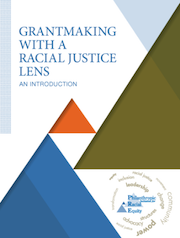Diversity, Equity, and Inclusion
Guide your philanthropy clients through the complexities of their work in diversity, equity and inclusion (DEI) with our DEI Toolkit for Consultants to Grantmakers.

In the 12 years since the original Grantmaking with a Racial Equity Lens guide was published the country’s political, economic, and cultural landscapes have undergone multiple, dramatic changes.
A combination of curated, synthesized, and original content, this library of resources is intended to help foundations and investors at different stages of practice begin to explore the many ways they can grow and deepen their commitments to racial equity and impact investing.

Asset Funders Network’s latest report, in collaboration with the Closing the Women’s Wealth Gap (CWWG) and the Insight Center for Community Economic Development reveals the current economic reality for millennial women and the primary drivers contributing to their wealth inequities.
For philanthropy to advance equity in all communities, especially low-income communities and communities of color, it needs to be able to understand the demographics of the organizations being funded (and declined), the people being served and the communities impacted. That data should be used to assess practices and drive decision making.
Evaluators, foundations and nonprofits need to examine the “fit” of our existing evaluation approaches with the principles and values that underlie grantmaking and efforts designed to advance equity.
These resources are from CNJG's 2016 Annual Meeting & Holiday Luncheon where the topic of shifting demographics was explored.
Based sardonically on Masterpiece Theatre, Washington Regional Association of Grantmakers’s Structural Racism Theater introduces the viewer to concrete examples of structural racism and implicit bias. It’s edgy, dryly humorous, “shareable,” and an incredibly different direction for WRAG. The first episode, "The Pernicious Compromise," focuses on the timely topic of the Electoral College and its connection to the Three-Fifths Compromise.
Based sardonically on Masterpiece Theatre, Structural Racism Theater introduces the viewer to concrete examples of structural racism and implicit bias in an edgy, social media-friendly way. In "Darkness in Emerald City," we look at the relationship between implicit bias and institutional racism.
Research shows that one of the greatest impediments to a prosperous future for all of Michigan's people is unequal access to resources. To help foundation leaders and their boards begin essential conversations about marginalized populations and determine the extent to which their organization's culture and grantmaking practices are aligned with a commitment to expanding opportunity in the communities they serve, CMF developed this discussion guide and self-assessment.
